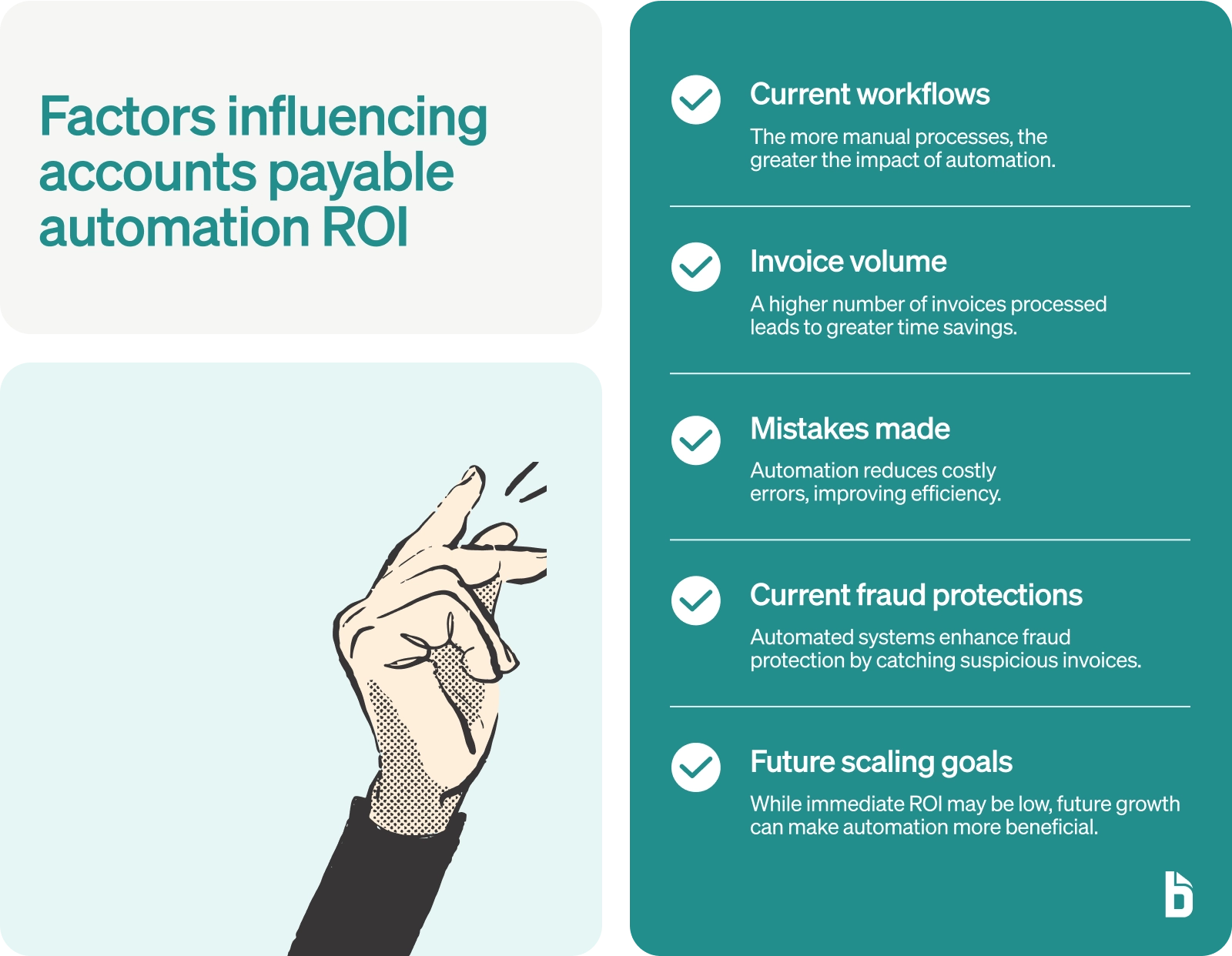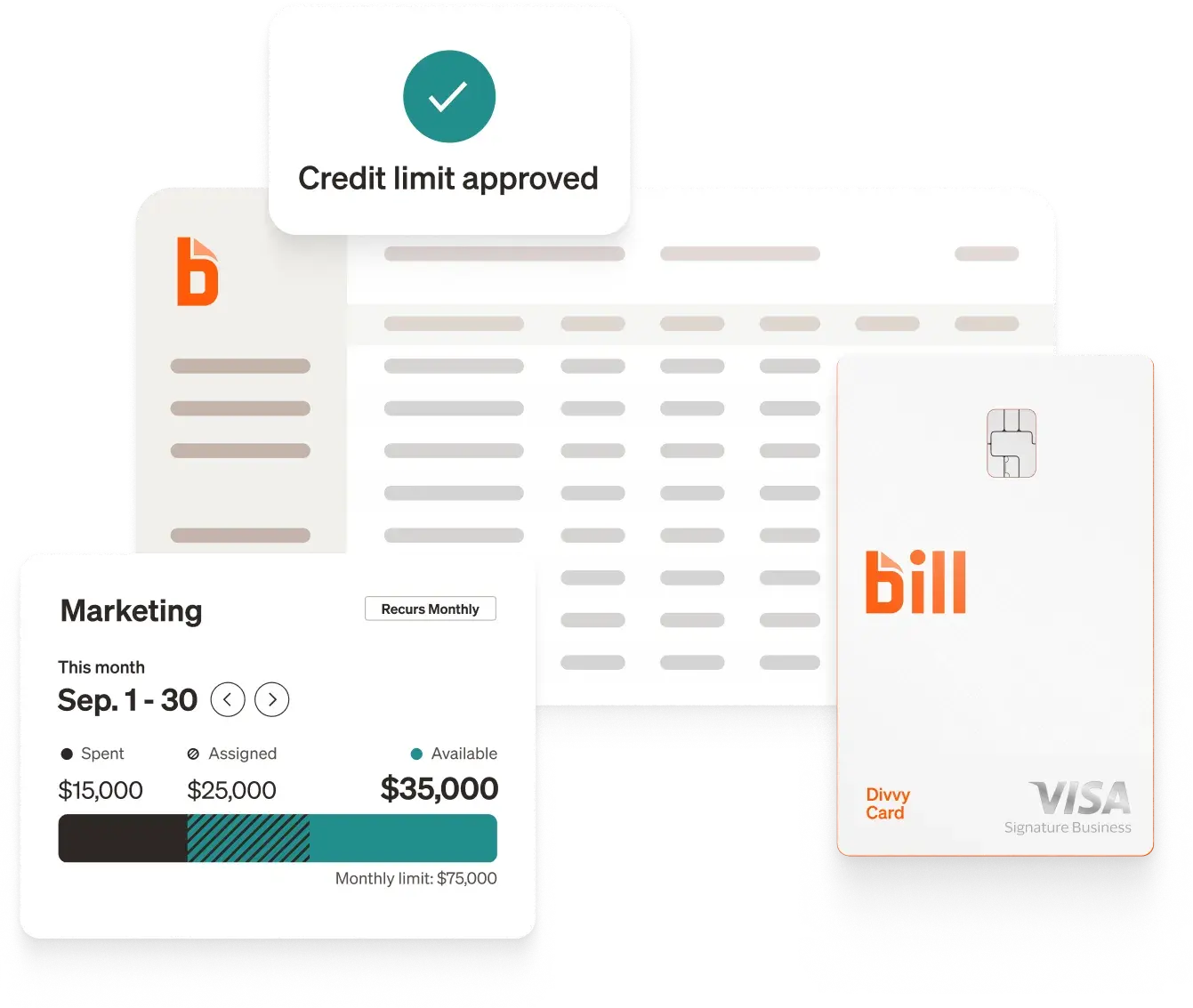Making the switch to a hot, new technology promising both time and cost savings seems like a great idea. What business wouldn’t want to save time and money?
But then you look at the price tag. The doubts may start to creep in as you contemplate whether the promises can actually make up for the money you’re handing over.
You may also face some pushback from higher ups, the finance team, and the workers who insist that the way it’s always been done is totally sustainable.
Fortunately, knowing whether a new technology like accounts payable automation has the right amount of impact on a business doesn’t have to be based on a hunch. What you need to do is calculate the ROI of AP automation, and this guide will walk you through the need-to-know info to do so.
Understanding accounts payable automation
AP automation software aims to simplify and streamline the accounts payable process by managing invoice processing, approvals, payments, and reconciliation.
Once an invoice is received, the software takes over using tech like optical character recognition (OCR) and AI to input information, match with supporting documents (like a purchase order), input the transaction, and kick off the invoice approval process.
At every step, the platform is there to ease the workload. If a task isn’t completely automated, it’s more efficient, taking advantage of the cloud to make information immediately accessible so all parties are working concurrently.
Benefits of implementing AP automation that increase ROI
Accounts payable automation impacts multiple parts of the AP process. Below are just some of the benefits from switching to an AP automation solution.
More efficient processes
By streamlining menial parts of the AP process, employees can focus on the higher level work that generates long-term value for the business. This means less time on data entry, reviewing for errors, chasing down individuals for approvals, and digging up past paper invoices for details.
Cost savings
The time saved on processing invoices has a dollar value that can be calculated. And if the business is looking to scale up, ultimately resulting in more invoices that need processing, it won’t have to increase its workforce to get the job done. Even if it saves the salary of one accounts payable clerk, that’s a salary of approximately $48,000.
Reduced errors
By leveraging technology like OCR, information is scraped directly from the invoice to be input into the system. This prevents human error that causes simple mistakes like a mistype or misreading of the invoice. Catching errors prevents incorrect payments getting through, saving the business money on processing fees, late fees, and duplicate payments.
Preventing fraudulent activity
AP automation prevents fraud by restricting access based on roles, using automated rules to catch invalid invoices, and using safer, electronic payment methods that keep banking information secure. It’s less likely that a fraudulent invoice gets through the approval process and the business is putting less sensitive information out there.
Improved vendor relations
A quicker process means a quicker time to payment. This helps businesses take advantage of early payment discounts and avoid late payment fees while building up good will with its vendors. With that good will, there’s room for negotiation on costs, potentially saving the business money and increasing the ROI of AP automation.

The factors that influence AP automation ROI
Nearly every business benefits from automation in any facet of their operations. But the question that matters when calculating ROI is whether the benefit is enough to warrant the cost.
This is where you need to look at the specifics of your operations.
In particular, you should consider the following factors before calculating the AP automation ROI:
- What are the current workflows? The more manual processes that make up your AP processes, the more tasks that will be impacted by implementing automation.
- How many invoices are processed in a month? AP automation saves you time on each invoice so it stands to reason that the greater the invoice volume, the greater the time savings.
- How many mistakes are made in a month? Mistakes are costly and eat up time that could be spent on more valuable tasks; AP automation produces consistent results, cutting down on errors.
- What are your current fraud protections? Automated systems enhance security by catching anomalous or unusual invoices that are potential fraud attempts
- What are the future scaling goals? A switch to automation may not pay off immediately, but if the business is looking to ramp up, there’s future benefits to consider.
Think about these questions and how they pertain to the business. The answers help determine what the potential ROI of AP automation could be.

Calculating accounts payable automation ROI
The ROI equation is as follows:
Return On Investment (ROI) = (Total Benefit - Cost of Investment) / Cost of Investment
Let’s dig into what this means in the context of AP automation.
The total benefit of implementing AP automation comes from time savings, fraud protection, and error reduction. To translate this into a financial number will take some cost estimation, specifically on the ROI of time savings.
A good starting point is the time it takes to process one invoice. This includes the data entry, document matching, reconciliation, approvals, and any other steps in the workflow.
Once you have a time estimate, multiply that by an hourly wage to see how much one invoice is costing the business to process.
As an example, if one invoice requires one hour across all steps in the process and a member of the accounting team has an hourly rate of $25, the cost of processing one invoice is $25. If the AP team is processing 100 invoices in a month, that means the total cost of process invoices is $2,500.
If AP automation cuts processing time in half, the net return of automation is $1,250 minus the monthly software and implementation costs (cost of investment). With these factors considered, you can calculate the accounts payable automation ROI for a single month.
This calculation requires some estimation to predict the ROI of AP automation. If you then decide to adopt AP automation, track these metrics to ensure the actual results are in line with your estimate.
Real world AP automation success stories
Much of what’s been covered so far has been theoretical. To showcase the real world ROI of AP automation, let’s dig into some actual success stories.
Keeping the accounting team lean and balanced
Galway Sustainable Capital is a small team that does big work. They invest in companies, projects, and assets that are committed to environmental and social sustainability in industries like energy, transportation, and real estate.
Working in this sector means auditing payments with a fine-tooth comb, a task that would require a huge effort by multiple people. But Galway Sustainable Capital manages with a smaller team by using BILL to automate and digitize the AP process.
“The accounting shop is lean,” says Nishil Patel, Vice President Controller for Galway. “And our team values flexibility and work-life balance.”
He adds: I came from a world of weekly AP runs, cutting and signing checks. Old-school accounting shops with filing cabinets full of hard-copy invoices. When it came time for an audit, someone had to physically pull everything. It just took a ton of time.”
“I came in at the tail end of an audit, completely new to BILL, and I was able to close out the audit without any trouble at all. The amount of time and paper BILL saves me has been wonderful,” Patel adds.
Read more on Galway Sustainable Capital’s success story.
Cutting down on time to payment
SF New Deal started up in 2020 with the goal of supporting San Francisco restaurants through the economic uncertainty of the COVID-19 pandemic. By providing grants to restaurants, they were able to stay open and continue to pay their staff despite the dip in business.
When providing a lifeline to locally-run businesses, efficiency is key—at one point, SF New Deal was distributing hundreds of grant checks in a month.
While the city had a goal of distributing grants within 30 days, that wasn’t good enough for SF New Deal. Melody Lan knew the businesses needed support sooner saying "When I first heard this, I wondered, oh, can we do better than that? Thirty days is a really long time to wait for your money."
With BILL, they were able to cut their average payment time by over half, and it continues to improve. Plus as a nonprofit, the improved reporting ensures they’re compliant with the necessary reporting.
Get more details on SF New Deal’s transition to AP automation.
Streamlining approvals on a remote team
When an office is split into multiple locations, getting approvals isn’t as simple as walking over to someone’s desk to kindly remind them of their responsibility. For ArtCube Nation, the two-person team is split between New York and Oklahoma.
“With BILL, the books stay current, everything gets put through, nothing is late,” says bookkeeper Brigot York. “If anyone needs more information about an invoice, we can document it right there in BILL. We have an easy-to-access, digital paper trail.”
“Previously, accounts payable (AP) was all done manually by text, and there was a lot of duplication or things being missed and behind. We needed to make AP more efficient, and we also needed more support for international payments.”
After implementing BILL, invoice approvals and communication are seamless and payments get sent out promptly, keeping their vendors (even the ones abroad) happy.
Learn more about how the switch to AP automation impacted ArtCube Nation.
Getting started with AP automation
Ready to start reaping the benefits of AP automation in your organization? BILL has you covered, for operations both big and small.
Leveraging integrations with some of the most popular accounting systems, BILL seamlessly fits into accounting tech stacks to keep reporting up-to-date without the manual data entry. And with a wide array of payment options available, one-click payments gets your vendors compensated in a way that works for you.
Sign up for a risk-free trial and give AP automation a test drive to see just how much of an impact and ROI it’ll have on your operations.








